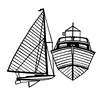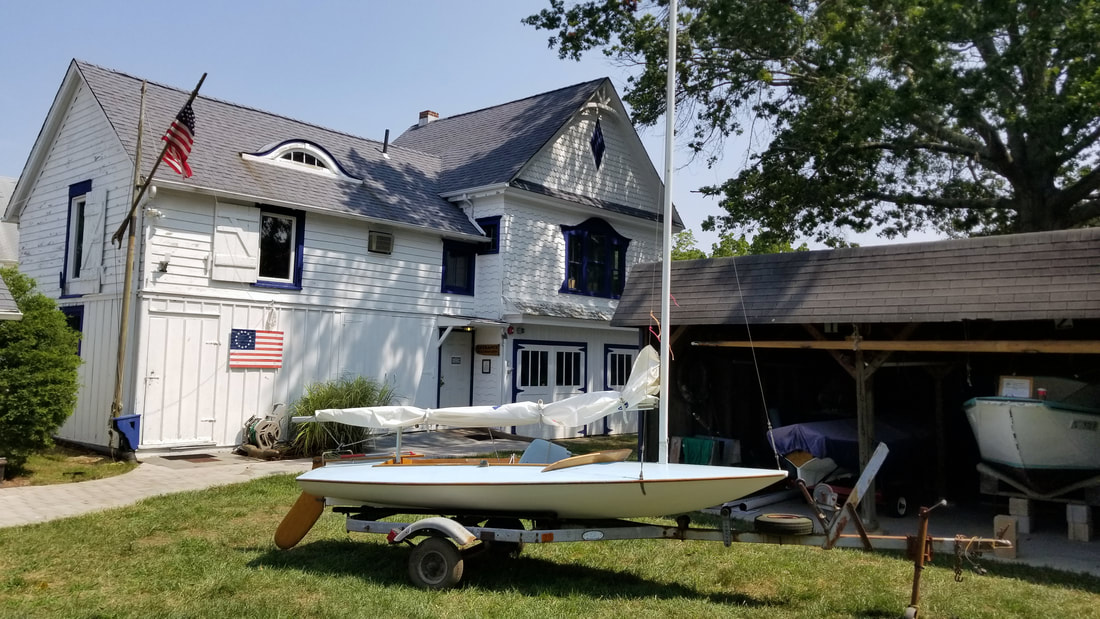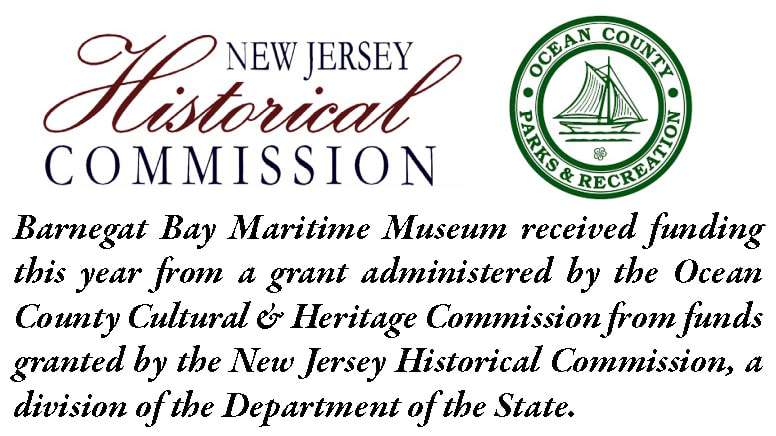|
Welcome to another Wooden Boat Wednesday!
This week begins a series from Kobbe's 1891 Jersey Coast and Pines guide, focused on our Barnegat Bay areas. Enjoy!
The earliest description of Barnegat Bay is found in the log of Henry Hudson's Half Moon. After getting out to sea from Delaware Bay, Hudson stood northeasterly making land September 2, 1609, probably near Great Egg Harbor. The same day the Half Moon passed Barnegat Bay and Barnegat Inlet. From the log book of the Half Moon, September 2, 1609:
"The course along the land we found to be northeast by north from the land which we first had sight of until we came to a great lake of water, as we could judge it to be, being drowned land which made its rise like islands, which was in length ten leagues. The mouth of the lake had many shoals, and the sea breaks upon them as it is cast out of the mouth of it. And from that lake or bay the land lies north by east and we had a great stream out of the bay." The lake mentioned in this extract is Barnegat Bay; the “mouth” of the lake, Barnegat Inlet. The reference to shoals proves that in those early days already the reefs on which many a gallant ship has fought its last fight existed. In fact, Barnegat Bay derives its name from the breakers whose foam hisses over these shoals, the name being a corruption from the Dutch Barning Gat, meaning Breakers Inlet, which was given to the inlet by the Dutch navigator Captain Mey, after whom Cape May is named. The tide still rushes as furiously through the inlet as it did when the sea was “cast out of the mouth of it, and the tall, slender light-house tower rises up from out of the dunes on the south side like a finger raised in warning. The inlet has always jealously guarded its rights against the efforts of the Government to erect lights to warn vessels off the treacherous shoals. It licked around the foundations of the light-house put up in 1834, until they melted away and the structure fell into the waves, which since then have been hurling themselves with such destructive force against the beach south of the inlet that there is now deep water where the old tower stood , and the site of that erected in 1858 is seriously threatened. This light-house, red and white, 165 feet above sea level, showing a first order light, flashing white every 10 seconds, is so exposed to the fury of winter storms, that the vibrations of the structure are violent enough to cause water in a pail placed on the floor of the top story to splash over. The wear and rapid changes produced upon the beach by Barnegat and other inlets through the beaches south of it can be readily understood when it is remembered that, for instance, the average rise and fall of tide in Barnegat Bay is 1 foot, which for its area of 72 1/2 square miles means that a volume of 2,016,000,000 cubic feet of water passes through Barnegat Inlet four times daily, making in the year more than thrice the amount which flows from the water-shed of the Hudson in the same time and that to the impetuous rush of the tide must be added the destructive effect of wave action. Barnegat Bay really resembles a lake more than a bay, so that the description of it in the log of the Half Moon is apt, It is separated from the ocean by two beaches, Squan and Long. That portion of the former, from the site of the old Cranberry Inlet (now closed), opposite Tom's River, to Barnegat Inlet is often called by its old name of Island Beach, the entire length of beach from the Manasquan to Barnegat Inlet being about twenty-four miles. Long Beach stretches from this inlet to Little Egg Harbor Inlet, a distance of about twenty-one miles. The depth of the bay north of the inlet scarcely exceeds ten feet anywhere, a considerable area next to the beach being less than five feet. Southward it reaches twenty feet near Lovelady Island. Barnegat Inlet has now about seven feet of water on its bar at low water, and from eleven to twelve feet at high tide. The bay is about twenty-seven miles long and from one to four miles broad . The west shore of the beach and the mainland across the bay are fringed with salt meadows, and in the bay itself are many sedgy islands, these being so numerous in places as to form a net-work of narrow, sinuous channels which the natives call thoroughfares or “slews” (sluice-ways). Metedeconk River, Kettle Creek, Tom's River, Cedar Creek, Forked River, Oyster Creek, Gunning River, and several smaller streams, flow into Barnegat Bay. There are settlements both on the narrow beaches and along the main shore. The beaches , having the ocean before them and the broad bay in their rear, seem to offer delightful sites for summer settlements. Between Bay Head and the point where the Philadelphia & Long Branch Railroad extension of the New York & Long Branch Railroad leaves the beach and crosses the bay to Tom's River are Mantoloking, Chadwick's (a famous old-fashioned gunning resort), Lavallette, Ortley, Berkeley Arms and Seaside Park. South of Barnegat Inlet are Barnegat City and Harvey Cedars. The expectations of the founders of some of the summer settlements among the places named have unfortunately not been realized , for certain winds bring the mosquitoes over to the beaches in such swarms that life becomes almost unendurable. Barnegat Pier is a station about half way across the Philadelphia & Long Branch R. R. bridge, from where many pleasure-boats start for the fishing-grounds down the bay. Barnegat Bay is the most northerly of a series of bays formed by a strip of beach on the east and the main shore on the west, and receiving the waters of the ocean through narrow inlets. These bays are separated from one another by encroachments of the salt meadows fringing their shores and by sedgy islands. Through the channels between these islands one can pass from bay to bay, so that it is possible to sail in small craft by an inland route from any of the resorts on Barnegat Bay clear through to Cape May. Enjoyed this article? Please consider making a one-time or recurring donation today!
Your donations support preserving and restoring our shared maritime heritage on the waters of Toms River and Barnegat Bay, through our boat workshop, educational programs and special events. Thank you.
Open Tuesdays, Thursdays, Saturdays - 10 am to 2 pm
78 East Water Street, Toms River, NJ 08753 Guided Tours By Request - New Members Always Welcome (732) 349-9209 - [email protected] Comments are closed.
|
NEWSArchives
May 2024
Categories |
OPEN TUES/THURS/SAT 10 to 2
Barnegat Bay Maritime MuseumVertical Divider
|
Upcoming EventsVertical Divider
|
|
© Barnegat Bay Maritime Museum. All rights reserved.




 RSS Feed
RSS Feed
